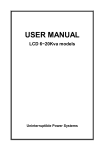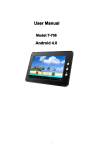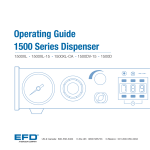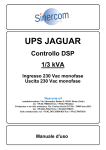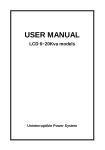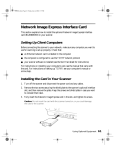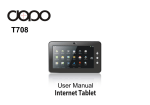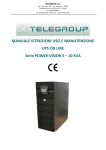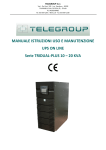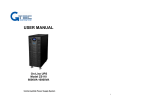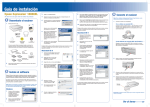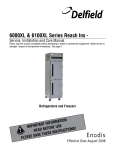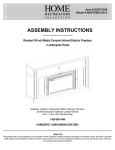Download MSII 6K 4U English neutral user manual
Transcript
UPS JAGUAR / LEOPARD 6/20 kVA Sinercom S.r.l. Headquarter: Via Alessandro Dudan 9- 00143 Rome (RM) - Italy tel. +39.06.79800323 fax +39.06.79814644 Factory: Via Cascina Secchi 247/4b - 24040 Isso (BG) - Italy tel. +39.0363.938231 fax +39.0363.998235 Commercial office: tel. +39.02.303126850/828 Fax +39.02.70051026 USER MANUAL Please comply with all warnings and operating instructions in this manual and on the unit strictly. Save this manual properly. Do not operate this unit before reading through all safety information and operating instructions carefully. 1. IMPORTANT SAFETY INSTRUCTION 1.Safety and EMC instructions Please read carefully the following user manual and the safety instructions before installing the unit or using the unit! 1.1 Installation ■Condensation may occur if the UPS is moved directly from a cold to a warm environment. The UPS must be absolutely dry before being installed. Please allow an acclimatization time of at least two hours. ■ Do not install the UPS near water or in damp environment. ■ Do not install the UPS where it would be exposed to direct sunlight or near heat. ■ Do not block ventilation openings in the UPS’s housing. ■ Do not connect appliances or items of equipment which would overload the UPS (e.g. laser printers, etc) to the UPS output. ■ Place cables in such a way that no one can step on or trip over them. ■UPS has provided earthed terminal, in the final installed system configuration, equipotential earth bonding to the external UPS battery cabinets. ■ An integral single emergency switching device which prevents further supply to the load by the UPS in any mode of operation should be provided in the building wiring installation. ■ An appropriate disconnect device as short-circuit backup protection should be provided in the building wiring installation. ■ For three-phase equipment connection to an IT power system, a four-pole device which disconnect all phase conductors and the neutral conductor should be provided in the building wiring installation. ■ This is permanently connected equipment , it must be installed by qualified maintenance personnel. ■ Earth connection essential before connecting to the building wiring terminal. 1.2 Operation ■ Do not disconnect the earth conductor cable on the UPS or the building wiring terminals in any time since this would cancel the protective earthing of the UPS system and of all connected loads ■ The UPS output terminal block may be electrically lived even if the UPS system is not connected to the building wiring terminal. ■ In order to fully disconnect the UPS, first press the OFF button, then disconnect the mains lead. ■ Ensure that no liquid or other foreign objects can enter the UPS. ■ The UPS can be operated by any individuals with no previous experience. 1.3 Maintenance, servicing and faults ■ The UPS operates with hazardous voltages. Repairs may be carried out only by qualified maintenance personnel. ■ Caution - risk of electric shock. Even after the unit is disconnected from the mains power supply (building wiring terminal), components inside the UPS are still connected to the battery which are potentially dangerous. ■ Before carrying out any kind of service and/or maintenance, please disconnect the batteries. Verify that no current is present and no hazardous voltage exists in the capacitor or BUS capacitor terminals. ■ Batteries must be replaced only by qualified personnel. ■Caution - risk of electric shock. The battery circuit is not isolated from the input voltage. Hazardous voltages may occur between the battery terminals and the ground. Verify that no voltage is present before servicing! ■ Batteries have a high short-circuit current and pose a risk of shock. Take all precautionary measures specified below and any other measures necessary when working with batteries: -remove all jewellery, wristwatches, rings and other metal objects - use only tools with insulated grips and handles. ■ When changing batteries, replace with the same quantity and the same type of batteries. ■ Do not attempt to dispose of batteries by burning them. It could cause explosion. ■ Do not open or destroy batteries. Effluent electrolyte can cause injury to the skin and eyes. It may be toxic. ■ Please replace the fuse only by a fuse of the same type and of the same amperage in order to avoid fire hazards. ■ Do not dismantle the UPS, except qualified maintenance personnel. 1.4 Transport ■ Please transport the UPS only in the original packaging (to protect against shock and impact). 1.5 Storage ■ The UPS must be stockpiled in the room where it is ventilated and dry. 2. Description of commonly used symbols Some or all of the following symbols may be used in this manual. It is advisable to familiarize yourself with them and understand their meaning: 3. Introduction 3.1 System and model description The On-Line-Series is an uninterruptible power supply incorporating double-converter technology. It provides perfect protection specifically for strict load. The double-converter principle eliminates all mains power disturbances. A rectifier converts the alternating current from the socket outlet to direct current. This direct current charges the batteries and powers the inverter. In the event of power failure, the maintenancefree batteries power the inverter. Thus the inverter generates a sine wave AC power, which permanently supplies the loads. Designed with the proven on-line, double conversion architecture, this series of UPS offers the greatest degree of availability in power protection and provides continuous high-quality AC power to connect strict load, especially for the basic equipments in some areas as: finance, communication, government, traffic, manufacture, education and so on. This manual is applicable to the following models: Type Standard Long back up time 6kVA UPS 10kVA UPS 10kVA UPS 10kVA UPS 15kVA UPS 3kVAS UPS Model JAGUAR 6000 JAGUAR 10000 LEOPARD 10000 JAGUAR/LEOPARD 1000XL LEOPARD 15000XL LEOPARD 20000XL Remark inbuilt inbuilt inbuilt External battery bank External battery bank External battery bank “XL”Model: Long backup time 3.2 Product Specification and Performance 1)General specification Power Rating 6KVA/4.8KW 10KVA/8KW 10KVA/8KW 15KVA/12W 20KVA/16W Model JAGUAR 6000 JAGUAR 10000 LEOPARD 10000 LEOPARD 15000XL LEOPARD 20000XL Frequ ency (Hz) 50/60 50/60 50/60 50/60 50/60 Input(full load) Voltage (176-276) VAC (176-276) VAC (304-478) VAC (304-478) VAC (304-478) VAC Current Output Voltage Dimensions (W*D*H) m Weight (kg) Current 31max 220V/230V 27A 248×500×616 57 50max 220V/230V 45A 248×500×616 67 50max 220V/230V 45A 248×500×885 88 75max 220V/230V 68A 248×500×616 35 100max 220V/230V 91A 248×500×616 35 2)Electrical performance INPUT Model JAGUAR 6000/10000 LEOPARD 10000/20000 Power Factor Voltage Frequency Single-phase 220VAC - 230VAC Three-phase 380VAC/220 VAC 380VAC/230 VAC 50/60Hz±5% (adjustable) >0.99(Full load) 50/60Hz±5% (adjustable) >0.95(Full load) OUTPUT Voltage regulation ±1% Power factor Frequency tolerance 0.8 Synchronized 46-54Hz in Line mode (AC mode) ±1% of normal frequency in Battery mode Distortion Overload capacity Current crest ratio THD<2% Full load (Linear load) 105%-125% load transfers to bypass mode after 1minutes >130% load transfers to bypass mode after 30second 3:1 maximum 3) Operating Environment Temperature Humidity Altitude Storage temperature 0 C-40 C <95% <1000m 0 C-40 C Note: if the UPS is installed or used in a place where the altitude is bove than 1000m, the output power must be derated in use, please refer to the following: Altitude (M) 1000 1500 2000 2500 3000 3500 4000 4500 5000 Derating Power 100% 95% 91% 86% 82% 78% 74% 70% 67% 4. Display Panel LCD Screen On/Off Button Select-Button Enter-Button T he following table describes the function of the button switches of the front panel. Button ON/OFF Button Select Button Enter Button Function This button has two functions: - Turning on the UPS system: By pressing this button the UPS system turns on. - Shut off the UPS system: When mains power is normal, the UPS System switches to Bypass mode by pressing OFF button , and the inverter is off . if the ups system is in bypass mode or self-test mode, the output ,frequency could be selected by pressing Select button, and confirmed by pressing Enter button. if the ups system is in bypass mode or self-test mode, the output ,frequency could be selected by pressing Select button, and confirmed by pressing Enter button. Mode/Fault/ Warni-ng code Set type Load Information Battery Voltage/ UPS temperature Input/output voltage and frequency information Battery information Indication of UPS work mode Display Function FAULT lighting indicates mode code, fault code and warning code, which could be displayed from 0 to99 ,SET lighting indicates the set code, type V (set voltage), F (set frequency) BATTERY lighting indicates the battery voltage value, which could be displayed from 0 to 999Vdc; TEMP lighting indicates the ups inside temperature, which could be displayed from 0 to 999℃ (The two items alternate displayed once every three seconds.) indicates the battery capacity. For example: 25% and 50% lighting synchronous, it means current battery capacity is 50%. LOW BAT lighting indicates the battery is weak, and the UPS should shut down soon,BATTERY FAULT lighting indicates indicates the present load value. For example: 25% and 50% lighting synchronous, it means current load is 50%. When load 100% lighting and the OVER LOAD lighting with warning, it means ups in overload Indicates ups input voltage value, output voltage value, output frequency value, which could be displayed from 0 to 999VAC (The four items alternate displayed once every three seconds.) 208, 220 ,230,240VAC The four value of the output voltage could be selected, 50/60HZ the two frequency value of the output voltage could be selected. indicates have mains power and when mode code display 02 that mean the ups working in Line mode. ECO lighting indicates ups working in ECO Mode. Lighting indicates ups charging, lighting and mode code display 03 that mean the ups working in battery mode. and lighting coinstantaneous and mode code display 03 that means UPS working in Bypass mode. and LOW BAT lighting coinstantaneous and UPS with warning that means Battery low voltage, the ups will would shut down soon. 5. Installation the system may be installed and wired only by qualified electricians in accordance with applicable safety regulations! 5.1 Unpacking and Inspection 1) Unpack the packaging and check the package contents. The shipping package contains: ● A UPS ● A user manual ● A communication cable ● A battery cable (for XL series only) 2) Inspect the appearance of the UPS to see if there is any damage during transportation. Do not turn on the unit and notify the carrier and dealer immediately if there is any damage or lacking of some parts. 5.2 Input and output power cords and protective earth ground installation 1. Notes for installation 1) The UPS must be installed in a location with good ventilation, far away from water, inflammable gas and corrosive agents. 2) Ensure the air vents on the front and rear of the UPS are not blocked. Allow at least 0.5m of space on each side. 3) Condensation to water drops may occur if the UPS is unpacked in a very low temperature environment. In this case it is necessary to wait until the UPS is fully dried inside out before proceeding installation and use. Otherwise there are hazards of electric shock. 2. Installation Installation and wiring must be performed in accordance with the local electric code and the following instructions by Professional personnel. or safety, please cut off the mains power switch before installation. The battery breaker also needs to be cut off if it is a long backup time model (“XL” model). 1) Open the terminal block cover located on the rear panel of the UPS, please refer to the appearance diagram. 2) For JAGUAR 6000 UPS, it is recommended to select the UL1015 10AWG (6mm2) wire or other insulated wire which complies with AWG Standard for the UPS input and output wirings. 3) For JAGUAR/LEOPARD 10000 UPS, it is recommended to select the UL1015 8AWG (10mm2) wire or other insulated wire which complies with AWG Standard for the UPS input and output wirings. 4) For LEOPARD 15000/20000 UPS,it is recommended to select the UL1015 6AWG (25mm2) wire or other insulated wire which complies with AWG Standard for the UPS input and output wirings. Note: Do not use the wall receptacle as the input power source for the UPS, as its rated current is less than the UPS’s maximum input current. Otherwise the receptacle may be burned and destroyed. 5) Connect the input and output wires to the corresponding input and output terminals according to the following diagram. Note: you must make sure that the input and output wires and the input and output terminals are connected tightly. 6) The protective earth ground wire refers to the wire connection between the equipment which consumes electric equipment and the ground wire. The wire diameter of protective earth ground wire should be at least as above mentioned for each model and green wire or green wire with yellow ribbon wire is used. 7) After having completed the installation, make sure the wiring is correct. 8) Please install the output breaker between the output terminal and the load, and the breaker should with leakage current protective function if necessary. 9) To connect the load with the UPS, please turn off all the loads first, then perform the connection and finally turn on the loads one by one. 10) No matter the UPS is connected to the utility power or not, the output of the UPS may have electricity. The parts inside the unit may still have hazardous voltage after turning off the UPS. To make the UPS have no output, power off the UPS, and then disconnect the utility power supply. 11) Suggest charging the batteries for 8 hours before use. After connection, turn the input breaker in the “ON” position, the UPS will charge the batteries automatically. You can also use the UPS immediately without charging the batteries first, but the backup time may be less than the standard value. 12) If it is necessary to connect the inductance load such as a monitor or a laser printer to the UPS, the start-up power should be used for calculating the capacity of the UPS, as its start-up power consumption is too big when it is started. Input and Output Terminal Block wiring diagram of JAGUAR 6000/10000 Input and Output Terminal Block wiring diagram of LEOPARD 10000/20000 5.3 Operating procedure for connecting the long backup time model UPS with the external battery 1. The nominal DC voltage of external battery pack is 192VDC. Each battery pack consists of 16 pieces of 12V maintenance free batteries in series. To achieve longer backup time, it is possible to connect multi-battery packs, but the principle of “same voltage, same type” should be strictly followed. 2. For JAGUAR 6000XL/10000XL and LEOPARD 10000XL/15000XL/20000XL, The procedure of installing battery bank should be omplied with strictly. Otherwise you may encounter the hazardous of electric shock.. 1) A DC breaker must be connected between the battery pack and the UPS. The capacity of breaker must be not less than the data specified in the general specification as follow. Model Battery voltage Battery current JAGUAR 6000 JAGUAR 6000XL JAGUAR 10000 JAGUAR 10000XL LEOPARD 10000 LEOPARD 10000XL LEOPARD 15000XL LEOPARD 20000XL 192VDC 192VDC 192VDC 192VDC 192VDC 192VDC 192VDC 192VDC 34A max 34A max 56A max 56A max 46A max 46A max 70A max. 102A max 2) Set the battery pack breaker in “OFF” position and connect the 16 pieces of batteries in series. 3. To complete the connection by plugging the connector of the external battery cable into the external battery socket of the UPS. Do not attempt to connect any loads to the UPS now. You should connect the input power wire to the right position first. And then set the breaker of the battery pack in the “ON” position. After that set the input breaker in the “ON” position. The UPS begins to charge the battery packs at the time. 5.4 Parallel operation 1. Brief introduction of the redundancy N+X is currently the most reliable power supply structure. N represents the minimum UPS number that the total load needs; X represents the redundant UPS number, i.e. the fault UPS number that the system can handle simultaneously. The bigger the X is, the higher reliability of the power system is. For occasions where reliability is highly required, N+X is the optimal mode. As long as the UPS is equipped with parallel cables, up to 3 of them can be connected in parallel to realize output power sharing and power redundancy. 2. Parallel installation 1) Users need to opt a standard 25-pin communication cable, which should have 25 cores, corresponding stitches and shield, as the UPS parallel cable. The length of the parallel cable is appropriate to be less than 3 m. 2) Strictly follow the stand-alone wiring requirement to perform the input wiring of each UPS. 3) Connect the output wires of each UPS to an output breaker panel first, and then connect the wiring to the load via the breaker panel. 4) The parallel UPS must be equipped with battery individually. 5) Please refer the figure followed to see the wiring of parallel operation. The capacity of the breaker must be not less than the specification as follow. Model No. Capacity of breaker JAGUAR 6000 ≥40A/250VAC JAGUAR/LEOPARD 10000 ≥60A/250VAC LEOPARD 15000/20000 ≥100A/250VAC *The requirement of the output wiring is as follows: ●When the distance between the UPSs in parallel and the breaker panel is less than 20 meters, the difference between the wires of input & output of the UPSs is required to be less than 20%; ●When the distance between the UPSs in parallel and the breaker panel is greater than 20 meters, the ifference between the wires of input & output of the UPSs is required to be less than 10%. 3. Operation and maintenance 1) To perform the general operation, follow the stand-alone operating requirement. 2) Startup: The units transfer to INV mode simultaneously as they start up sequentially in Line mode. 3) Shutdown: the units shut down sequentially in INV mode. When the last one completes the shutdown action, each unit will shut down the inverter simultaneously and transfer to Bypass mode. It is easy to operate the equipment, with no previous training. You just need to read through this manual and operate according to the instructions in it. Parallel Installation Diagram 4) To perform the maintenance, follow the stand-alone requirement WIRING DIAGRAM OF JAGUAR WIRING DIAGRAM OF LEOPARD 6. Operation 6.1 Operation Mode 1. Turn on the UPS with utility power supplied (in Line mode) 1) After you make sure that the power supply connection is correct, and then set the breaker of the battery pack in the “ON” position (this step only for long backup time model), after that set the input breaker in the “ON” position. At this time the fan rotates and the UPS supplies power to the load via the bypass. The UPS operates in Bypass mode, the mode code is “01”. 2) To power on the UPS by simply pressing the ON button continuously for more than 1 second, the buzzer will beep once. 3) A few seconds later, the UPS turn into Line mode, and the mode code is “02”. If the utility power is abnormal, the UPS will operate in Battery mode without output interruption of the UPS. 2. Turn on the UPS with no utility power supplied (in Battery mode) 1) After you make sure that the breaker of the battery pack is in the “ON” position (this step only for long backup time model). 2) Press the ON button continuously for more than 1 second to power on the UPS, and the buzzer will beep once, UPS operates in No Output mode, the mode code is “00”. 3) A few seconds later, the UPS turn into Battery mode, and the mode code is “03”. 3. Turn off the UPS with utility power supplied (in Line mode) 1) To turn off the inverter of the UPS by pressing the OFF button continuously for more than 1 second, and the buzzer will beep once. The UPS will turn into Bypass mode. 2) Upon completion of the above to turn it off, output of electric current of the UPS is still present. In order to cut off the output from the UPS, simply cut off the utility power supply, a few seconds later, there are not any display is shown on the display panel and no voltage output is available from the UPS output. 4. Turn off the UPS with no utility power supplied (in Battery mode) 1) To power off the UPS by pressing the OFF button continuously for more than 1 second, and the buzzer will beep once. 2) When being powered off, the UPS will turn into No Output mode. Finally not any display is shown on the display panel and no voltage is available from the UPS output. Suggestions: Please turn off the connected loads before turning on the UPS and turn on the loads one by one after the UPS is working in INV mode. Turn off all of the connected loads before turning off the UPS. 7. Battery Maintenance ● This series UPS only requires minimal maintenance. The battery used for standard models are value regulated sealed lead-acid maintenance free battery. These models require minimal repairs. The only requirement is to charge the UPS regularly in order to maximize the expected life of the battery. When being connected to the utility power, whether the UPS is turned on or not, the UPS keeps charging the batteries and also offers the protective function of overcharging and over-discharging. ● The UPS should be charged once every 4 to 6 months if it has not been used for a long time. ● In the regions of hot climates, the battery should be charged and discharged every 2 months. The standard charging time should be at least 12 hours. ● Under normal conditions, the battery life lasts 2 to 4 years. In case if the battery is found not in good condition, earlier replacement should be made. Battery replacement should be performed by qualified personnel. ● Replace batteries with the same number and same type of batteries. ● Do not replace the battery individually. All the batteries should Be replaced at the same time following the instructions of the battery supplier. ● Normally, the batteries should be charged and discharged once every 4 to 6 months. Charging should begin after the UPS shuts down automatically in the course of discharging, the standard charging time for the standard UPS should be at least 12 hours. 8. Notes for Battery Disposal and Battery Replacement 1) Before disposing of batteries, remove conductive jewelry such as necklace, wrist watches and rings. 2) If it is necessary to replace any connection cables, please purchase the original materials from the authorized distributors or service centers, so as to avoid overheat or spark resulting in fire due to insufficient capacity. 3) Do not dispose of batteries or battery packs in a fire, they may explode. 4) Do not open or mutilate batteries, released electrolyte is highly poisonous and harmful to the skin and eyes. 5) Do not short the positive and negative of the battery electrode, otherwise, it may result in electric shock or fire. 6) Make sure that there is no voltage before touching the batteries. The battery circuit is not isolated from the input potential circuit. There may be hazardous voltage between the battery terminals and the ground. 7) Even though the input breaker is disconnected, the components inside the UPS are still connected with the batteries, and there are potential hazardous voltages. Therefore, before any maintenance and repairs work is carried out, switch off the breaker of the battery pack or disconnect the jumper wire of connecting between the batteries. 8) Batteries contain hazardous voltage and current. Battery maintenance such as the battery replacement must be carried out by qualified personnel who are knowledgeable about batteries. No other persons should handle the batteries. 10. Operating mode for all models The different codes could be displayed on the LCD screen corresponding to their own operating modes, and they are illustrated as the follow: Operating mode Code Operating mode Code Mode Code Table Parallel Mode Bypass mode Line mode 02 01 02 Battery mode Battery test mode 03 04 Warning Code Table ID Loss Fan Error Battery Low 21 10 12 Charger Bad IP Fuse Open 13 11 Fault Code Table Bus Fault Overload Fault Other 05 07 09 Inverter Fault Over temperature Fault 06 08 15 10.1 Bypass mode The LCD display in Bypass mode is shown in the following diagram. The information about the utility power, the battery, the UPS temperature and load could be displayed. The operating mode code of the UPS is “01”. The UPS will beep once every 2 minutes in Bypass mode. Bypass mode 10.2 Line mode The LCD display in Line mode is shown in the following diagram. The information about the utility power, the battery, the temperature and load could be displayed, The operating mode code of the UPS is “02”. Line mode If output overloaded, the load percent is shown and alarm will keep twice every second. You should get rid of some unnecessary loads one by one to decrease the loads connected to the UPS less than 90% of its nominal power capacity. 10.3 Battery mode The LCD display in Battery mode is shown in the following diagram. The information about the utility power, the battery, the temperature and load could be displayed. The operating mode code of the UPS is “03”. 1) When the UPS is running in Battery mode, the buzzer beeps once every 4 seconds. If the ENTER button on the front panel is pressed for more than 1 second again, the buzzer will stop beeping (in silence mode). Battery mode 10.4 Self-Test mode The LCD display in Battery mode is shown in the following Diagram.The information about the utility power, the battery, emperature and load could be displayed. The operating mode code of the UPS is “04”. Self-Test mode 10.5 Parallel mode The LCD display in parallel mode is shown in the following diagram. When the UPS operating in parallel mode, the operating mode code of the UPS is “P2”. Parallel mode 10.6 Warning mode The LCD display in warning mode is shown in the following diagram. the symbol “WARNING” is shown instead in code display. Warning mode 10.7 Fault mode The LCD display in fault is shown in the following diagram. The symbol “MODE” not be shown and the symbol “FAULT” is shown instead in code display. Fault mode (Bus Fault) 10.8 Set Mode The LCD display in voltage set is shown in the following diagram. Set Voltage The LCD display in Frequency set is shown in the following diagram. 10.9 Battery Low voltage warning The LCD display in Battery Low voltage warning is shown in the following diagram. Notice:When Battery low voltage or short back-up time, both low-voltage marker and clock marker would bright synchronously 10.10 Battery Low voltage warning The LCD display in Battery Low voltage warning is shown in the following diagram. Note: The above all diagrams: temperature, battery voltage, Input voltage, input frequency, output voltage, output frequency would alternately displayed in each mode (once every three seconds) 11. Communication Port 11.1 RS232 Interface The following is the pin assignment and description of DB-9 connector. Pin # 2 3 5 Description TXD RXD GND I/O Output Input Input 11.2 Intelligent slot This series is equipped with an intelligent slot for Webpower (optional accessory) or other optional card to achieve remote management of the UPS through internet / intranet. Please contact your local distributor for further information. 11.3 AS400 Interface (Option) Except for the communication protocol as mentioned above, this series UPS has AS400 card (an optional accessory) for AS400 communication protocol. Please contact your local distributor for details. The following is the pin assignment and description of DB-9 connector in AS400 card. Pin # 1 2 3 4 5 Description UPS Fail Summary Alarm GND Remote Shutdown Common I/O Output Output Input Pin # 6 7 8 Description Bypass Battery Low UPS ON I/O Output Output Output Input 9 Line Loss Output Input DB-9 Interface of AS400 communication protocol Appendix1:Rear Panel BACK VIEW of JAGUAR 6000 / 10000 BACK VIEW of LEOPARD 10000XL/15000XL/20000XL (1) RS232 (2) Inteligent Solt (3) Fan (4) Parallel Port (5) Input Breaker (6) Maintain Switch (7) Terminal Block Cover (8) Cable Rack (9) EPO BACK VIEW of LEOPARD 10000


























